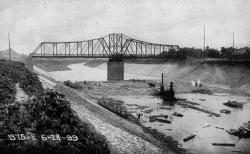
Until 1900, the Chicago River drained into Lake Michigan, along with all the sewage from the city; and the Des Plaines River west of Chicago emptied into the Illinois River, which eventually flows to the Mississippi. Chicago residents drew their drinking water from polluted areas of the lake near the mouth of the Chicago River, leading to outbreaks of typhoid and other waterborne diseases.
By 1889, the Sanitary District of Chicago was organized to combat the city's sanitation problems. One of the District's first projects was a canal connecting the Chicago River with the Des Plaines River, cutting through a line of hills west of the city. This allowed a regulated amount of water to flow out of Lake Michigan, through the Chicago River, and into the Illinois River. The reversal program resulted in a multi-purpose project involving water supply, pollution control, transportation, and power generation.
Facts
- The completion of the entire project eventually resulted in the construction of a river 31 miles long and 26 feet deep. The entire project cost over $70 million.
- Thirteen bridges were built over the main canal. All are moveable bridges, so that canal boats can pass through.
- Seven sluice gates, each 30 feet wide, and a movable dam 160 feet long were built at Lockport. By opening these gates or lowering the dam, the amount of water flowing in the main channel can be regulated at all times.
- Engineering techniques and earthmoving machines develop during construction of the Chicago Sanitary & Ship Canal were used to build the Panama Canal.
- In 1885, a huge storm dumped more than six inches of rain on the city within a two-day period. The heavy rainfall flushed the streets, catch basins, and sewers into the river and polluted the lake far beyond the intake cribs that supplied the city's drinking water. Roughly 1.2 percent of the city's population became sick and died from cholera, typhoid, and dysentery in the aftermath of this storm.


